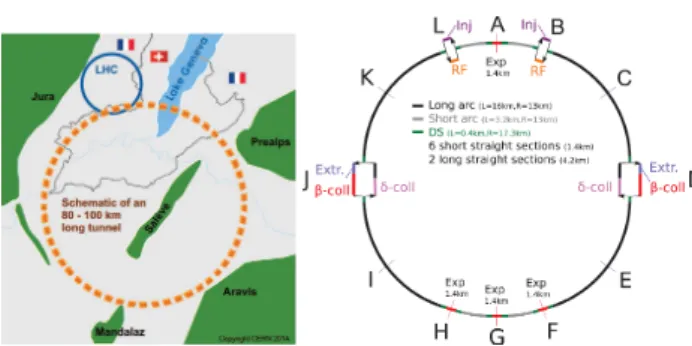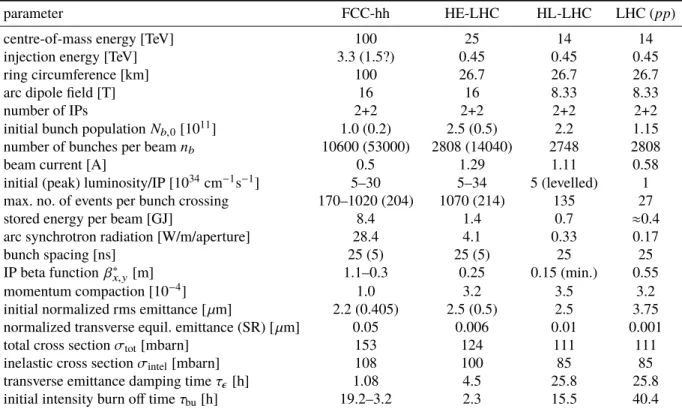BEAM DYNAMICS ISSUES IN THE FCC ∗
W. Bartmann, M. Benedikt, M.I. Besana, R. Bruce, O. Brüning, X. Buffat, F. Burkart, H. Burkhardt, S. Calatroni, F. Cerutti, S. Fartoukh, M. Fiascaris, C. Garion, B. Goddard, W. Höfle, B. Holzer, J.M. Jowett, R. Kersevan, R. Martin, L. Mether, A. Milanese, T. Pieloni, S. Redaelli, G. Rumolo,
B. Salvant, M. Schaumann, D. Schulte, E. Shaposhnikova, L.S. Stoel, C. Tambasco, R. Tomas, D. Tommasini, F. Zimmermann † , CERN, Switzerland; G. Guillermo, CINVESTAV Merida, Mexico;
V. Kornilov, GSI Darmstadt, Germany; O. Boine-Frankenheim, U. Niedermayer, TU Darmstadt, Germany; T. Mitsuhashi, K. Ohmi, KEK, Japan; A. Chancé, B. Dalena, J. Payet, CEA, Saclay, France; P. Bambade, A. Faus-Golfe, J. Molson, LAL Orsay, France; J.-L. Biarrotte,
A. Lachaize, IPNO, France; J. Fox, G. Stupakov, SLAC, U.S.A.; J. Abelleira, E. Cruz, A. Seryi, JAI Oxford, U.K.; R. Appleby, U. Manchester, U.K.; M. Boscolo, F. Collamati, A. Drago, INFN-LNF, Italy; J. Barranco, EPFL, Switzerland; S. Khan, B. Riemann, TU Dortmund, Germany
Abstract
The international Future Circular Collider (FCC) study [1] is designing hadron, lepton and lepton-hadron colliders based on a new 100 km tunnel in the Geneva region. The main focus and ultimate goal of the study are high-luminosity proton-proton collisions at a centre-of-mass energy of 100 TeV, using 16 T Nb
3Sn dipole magnets.
Specific FCC beam dynamics issues are related to the large circumference, the high brightness — made available by radiation damping —, the small geometric emittance, unprecedented collision energy and luminosity, the huge amount of energy stored in the beam, large synchrotron radiation power, plus the injection scenarios.
In addition to the FCC-hh proper, also a High-Energy LHC (HE-LHC) is being explored, using the FCC-hh magnet technology in the existing LHC tunnel, which can yield a centre-of-mass energy around 25 TeV.
MOTIVATION AND SCOPE
The Large Hadron Collider (LHC) [2] and its high- luminosity upgrade, the HL-LHC [3], have an exciting physics programme, which, covering the next 20 years, ex- tends through the mid 2030s. Counting from the start of its design study in 1983, more than 30 years were needed to design, build and commission the LHC. Therefore, the community must now urgently start preparing the next ac- celerator for the post-LHC period, as it has clearly been recognized by the 2013 Update of the European Strategy for Particle Physics [4].
A large circular hadron collider seems to be the only ap- proach to reach energy levels far beyond the range of the LHC, during the coming decades, so as to provide access to new particles with masses up to tens of TeV, through direct production, as well as to obtain tremendously increased pro- duction rates for phenomena in the sub-TeV mass range, with
∗This work was supported in parts by the European Commission under the Capacities 7th Framework Programme project EuCARD-2, grant agreement 312453, and the HORIZON 2020 project EuroCirCol, grant agreement 654305, as well as by the German BMBF.
†frank.zimmermann@cern.ch
the corresponding greatly improved precision and enhanced sensitivity to new physics.
The energy reach of a high-energy hadron collider is sim- ply proportional to the dipole magnetic field and to the bend- ing radius: E ∝ B × ρ. Assuming a dipole field of 16 T, achievable with Nb
3Sn technology, the ring circumference must be about 100 km in order to reach the target value 100 TeV for the centre-of-mass energy.
Figure 1 presents a schematic of the FCC tunnel along with a sketch of the hadron collider layout. Prior to FCC- hh installation, the new 100 km tunnel could host a high- luminosity circular e
+e
−collider (FCC-ee). Concurrent operation of hadron and lepton colliders is not foreseen how- ever. In addition, the FCC study considers aspects of pe collisions (FCC-he), as could be realized, e.g., by colliding the electron beam from an energy recovery linac (ERL) with one of the two FCC-hh hadron beams.
In the frame of the FCC study another future hadron col- lider is being studied, the so-called High Energy LHC (HE- LHC). The HE-LHC would be based on FCC-hh magnet technology, but be installed in the existing 26.7 km tunnel, which is presently housing the LHC.
Historically, investigations of an earlier version of the HE-LHC [5] gave birth to the FCC concept.
Figure 1: Left: Schematic of a 100 km tunnel for a Future Circular Collider (FCC) in the Lake Geneva basin. Right:
Layout of the FCC-hh ring. © 2016 CC-BY -3.0 and by the respecti v e authors
PARAMETERS AND OPTIONS
Table 1 compares key parameters of FCC-hh [6] and HE- LHC (preliminary) with those of LHC and HL-LHC. The FCC-hh design considers parameter sets for two phases of operation [7]: Phase 1 (baseline) aims at a peak luminosity of 5 × 10
34cm
−2s
−1, and should deliver about 250 fb
−1per year on average. In Phase 2 (ultimate) the peak luminosity is increased by almost a factor of six, to about 3 ×10
35cm
−2s
−1, and the integrated luminosity by a factor of four to 1000 fb
−1per year.
The initial proton burn-off time can be computed as τ
bu= N
bn
b/(L
0σ
totn
IP), where N
bdenotes the bunch population, n
bthe number of bunches per beam, and n
IPthe number of high-luminosity interaction points (IPs); n
IP= 2 for all four colliders under consideration.
For both FCC-hh and HE-LHC there is an option of op- erating with a reduced bunch spacing of 5 ns, instead of the 25 ns spacing used at the LHC and HL-LHC. The total beam current would be the same, so that for 5 ns spacing the bunch charge is reduced by a factor of 5. To maintain the same luminosity (and the same beam-beam tune shift), the emittance also needs to be reduced by a factor 5, which appears possible — at least during the course of a physics fill — thanks to the strong radiation damping. The main advantage of 5 ns spacing is a factor five lower event pile up per bunch crossing in the particle-physics detectors. Possi- ble disadvantages include much reduced transverse Landau damping and potentially aggravated eletron-cloud effects.
LUMINOSITY EVOLUTION
The four hadron colliders operate in different regimes.
At the LHC, the intensity decreases due to burn off. For the HL-LHC it is held constant by levelling (e.g. dynamic change of β
∗x,yduring a physics fill [8]). In either of these two cases, the transverse emittances do not much evolve during a fill, since the weak radiation damping is roughly balanced by the effects of intrabeam scattering, gas scattering and beam-beam-related phenomena.
By contrast, for the FCC-hh the radiation damping is extremely strong, faster than the burn off. As a result the total beam-beam tune shift , ∆Q
bb, and luminosity increase during the physics fill. From a certain moment onwards, the emittance shrinkage may need to be counteracted by controlled noise excitation, especially in Phase 1, in order for the beam-beam tune shift or detector pile-up not to exceed the empirical limits.
For the HE-LHC, the situation is again different. Here, the initial proton burn off is (two times) faster than the emittance shrinkage. In consequence, both the luminosity and the tune shift naturally decrease with time.
Figure 2 presents the evolution of instantaneous luminos- ity, integrated luminosity, bunch population, emittance, pile up and beam-beam tune shift for both phases of FCC-hh over 24 h of running. Here, we assume that the injected beam corresponds to the baseline parameters and a beam-beam tune shift of ∆Q
tot≈ 0.01. In Phase 2 the emittances are
0 5 10 15 20
0 5 10 15 20 25
time [h]
34 -2 -1 luminosity [10 cm s ]
phase 1 phase 2
0 5 10 15 20
0 2 4 6 8
time [h]
integrated luminosity [fb ]-1
phase 1 phase 2
0 5 10 15 20
0 0.2 0.4 0.6 0.8
time [h]
phase 1 phase 2 bunch intensity [10 ]11
0 5 10 15 20
0 0.5 1 1.5 2
time [h]
phase 1
phase 2 normalized rms emittance [mm]
0 5 10 15 20
0 0.005 0.01 0.015 0.02 0.025 0.03
time [h]
total beam-beam tune shift
phase 1 phase 2
0 5 10 15 20
0 200 400 600 800
time [h]
event pile up per bunch crossing
phase 1 phase 2

![Table 1 compares key parameters of FCC-hh [6] and HE- HE-LHC (preliminary) with those of HE-LHC and HL-HE-LHC](https://thumb-eu.123doks.com/thumbv2/1library_info/3773548.1512893/2.889.468.793.74.397/table-compares-parameters-fcc-lhc-preliminary-lhc-lhc.webp)

